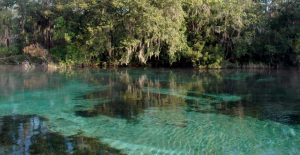It’s Florid a Water Bill Day! A new water law becomes effective in Florida today, July 1, 2016. Most famously known as the “Water Bill,” this Florida legislation was 2 years in the making and has a little something for everyone, from Florida homeowners, to farmers, to developers, and environmentalists. Here are 6 key things you need to know about the 2016 Florida Water Bill.
a Water Bill Day! A new water law becomes effective in Florida today, July 1, 2016. Most famously known as the “Water Bill,” this Florida legislation was 2 years in the making and has a little something for everyone, from Florida homeowners, to farmers, to developers, and environmentalists. Here are 6 key things you need to know about the 2016 Florida Water Bill.
- The bill creates the Florida Springs and Aquifer Protection Act, which is aimed at protecting Florida springs fed by the Floridan Aquifer. The legislature finds that many of these springs are threatened by excessive groundwater withdrawals and by polluted runoff. The excessive groundwater withdrawals have to do with an ever-growing Florida population and the fact that we get most of our public supply water from groundwater. The state must now establish minimum flow levels (MFLs) for these springs. The MFLs set a limit at which further groundwater withdrawals would be harmful to the spring area ecology. Polluted runoff into the springs comes from materials–mainly nutrients and pathogens–carried by stormwater to the spring headwaters. As stormwater runs over the land, it picks up all kinds of pollutants, like excess nutrients from fertilizers, bacteria from the dog waste not picked up and properly disposed of by dog owners, and oil droplets on parking lots and roads. Stormwater then delivers all those pollutants picked up along the way to water bodies across the state.
- Under the Florida Springs and Aquifer Protection Act, a Basin Management Action Plan (BMAP) must be established anytime a Florida Outstanding Spring (those with flows of at least 100 cubic feet per second) is found to be impaired by a given pollutant. The BMAP must outline priorities for identifying sources of the pollutant and taking corrective action. Specifically, this law requires any municipality within a Florida Outstanding Springs BMAP to adopt fertilizer ordinances and to begin a program of septic system remediation, a nod to the fact that improperly sited or poorly maintained septic systems are a leading contributor to water pollution. Further, no new septic systems will be allowed on lots smaller than 1 acre, and new agricultural operations in the area must agree to pollution-reducing best management practices (BMPs). This act is most noteworthy to rural residents who rely on septic systems to treat domestic wastewater, as the costs to make necessary remediations may be large.
- The 2016 Florida Water Bill codifies the Central Florida Water Initiative (CFWI). The CFWI is a collaborative water planning body authorized to pursue alternative water supply projects within areas of Orange, Osceola, Polk, Seminole, and Lake counties where there is restricted water supply. The Florida Department of Environmental Protection is now mandated to adopt rules regarding permit reviews, conservation goals, and recovery strategies in the CFWI. This means the CFWI must adopt a single, multidistrict regional water supply plan, including needed recovery or prevention strategies and a list of water supply development or resource projects. While this work must be commenced by the end of this year, in reality, much of it has already been done and is found in the CFWI regional water supply plan.
- The law goes beyond emphasizing enrollment in the state agricultural BMP program by mandating a new emphasis on BMP implementation. Agricultural producers within BMAP areas will be required to enroll in BMP programs and provide documentation of BMP implementation, or they must set up a water quality monitoring program on their property.
- Water management districts are directed to promote expanded cost-share criteria for additional conservation practices, such as
 soil moisture sensors and other irrigation improvements, water-saving equipment, water-saving household fixtures and software technologies that can achieve verifiable water conservation. Look for new or expanded cost-share programs with an emphasis on water conservation tools and programs.
soil moisture sensors and other irrigation improvements, water-saving equipment, water-saving household fixtures and software technologies that can achieve verifiable water conservation. Look for new or expanded cost-share programs with an emphasis on water conservation tools and programs. - Finally, the Water Bill puts expanded emphasis on South Florida ecology, specifically the detrimental conditions associated with excess water flows from Lake Okeechobee. While agricultural BMPs are already extensively in place for the watershed, the law now stipulates that where water quality problems are detected for nonagricultural nonpoint sources despite the appropriate implementation of adopted BMPs, FDEP and water management districts shall institute a reevaluation of practices so rules can be revised to require implementation of the modified practices within a reasonable time period. This has important implications for urban stormwater managers, who may find themselves in need of retrofitting urban stormwater infrastructure.
 0
0

